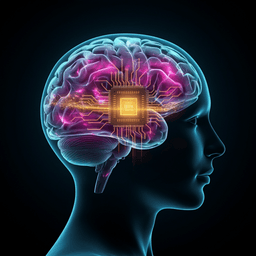
Computer Science
Memristor networks for real-time neural activity analysis
X. Zhu, Q. Wang, et al.
Discover how Xiaojian Zhu, Qiwen Wang, and Wei D. Lu are revolutionizing real-time neural signal analysis with their innovative memristor-based reservoir computing system. This groundbreaking research promises to enhance our understanding of neural communication and function with high precision and potential for closed-loop feedback control.
~3 min • Beginner • English
Introduction
The study targets real-time analysis of neural spike trains directly at the point of recording to overcome limitations of current workflows that require transmitting, digitizing, storing, and offline processing of large electrophysiology datasets. Such conventional pipelines impose severe power and bandwidth constraints on neural probes and preclude closed-loop feedback. Reservoir computing (RC), with its dynamic nonlinear projection and fading memory, is well-suited for temporal data like neural spikes. Dynamic memristors inherently possess short-term memory due to ionic migration and relaxation, enabling them to serve as physical reservoirs. The research question is whether a low-voltage, low-current perovskite halide memristor can act as a reservoir directly driven by neural-like spikes to perform on-site, real-time tasks such as firing pattern recognition, transition detection, and neural synchronization analysis.
Literature Review
Prior work on neural recording includes patch clamp, nanowire FETs, MEMS probes, and CMOS nanoelectrode arrays, which capture intracellular and intercellular spikes but typically require data transfer and offline analysis, including with artificial neural networks. Reservoir computing, derived from recurrent neural networks, projects inputs into high-dimensional state spaces with fading memory, enabling temporal pattern processing with simple linear readout layers. Dynamic memristors (e.g., oxide-based) have been used as reservoirs for temporal tasks, but commonly require higher programming voltages (~1 V) and currents (>10 µA). Perovskite halides offer low ion migration barriers and low intrinsic defect densities, suggesting potential for ultralow-voltage operation. Prior studies indicate resistive switching in perovskites involves halide vacancy formation and possible electrochemical interactions with electrodes, supporting their suitability for low-power dynamic memristors.
Methodology
Device and materials: Planar Ag/CsPbI3/Ag memristors were fabricated on SiO2/Si. Electrodes (Ag 200 nm / Au 100 nm / Ti 5 nm) with ~200 nm spacing were patterned by photolithography and e-beam evaporation, followed by lift-off. CsPbI3 precursor (40 wt%) was prepared in DMF, spin-coated at 4000 rpm for 60 s with antisolvent toluene drop at ~11 s, then annealed at 100 °C for 30 min. Ag electrodes were CF4 plasma treated before coating. Device characterization: Electrical tests used a probe station and Keithley 4200S with SMU/PMU; SEM/EDX with Hitachi SU8000.
Memristor operation characterization: After forming, DC sweeps (0→100→0 mV) probed SET behavior with 1 nA compliance. SET voltage statistics were collected over 46 sweeps. EDX pre/post-SET assessed iodine content changes. Cyclic voltammetry probed redox behavior. Pulse programming used 100 mV pulses with widths from 500 µs to 5 ms; read pulses at 30 mV were used to monitor relaxation dynamics.
Neural spike emulation: Neural spikes were emulated by square pulses of 100 mV amplitude and 2 ms width. For pattern recognition, each spike train lasted 620 ms. Patterns: Tonic (low-frequency, near-constant intervals 60–80 ms with 5% SD); Bursting (groups of 3–6 spikes, 10 ms intra-group interval, 100–200 ms inter-group with 10% and 8% SD respectively); Irregular (50 segments of 12 ms each, 50% spike probability per segment); Adapting (start interval 6 ms, subsequent intervals increase by 30% with 5% SD). Transition sequences concatenated two patterns with each segment 25–75% of total length. For synchronization analysis, Bursting trains were generated for each neuron: in-phase (simultaneous spikes with 10% SD), anti-phase (alternating with 10% SD), or no phase synchronization (uncorrelated timing).
Reservoir construction with virtual nodes: A single physical memristor served as the nonlinear node; reservoir states were expanded via virtual nodes sampled every 20 ms during input application. Over 620 ms, 31 virtual node states were collected (t = 20n ms, n = 1–31). Read pulses were −30 mV, 0.5 ms.
Readout networks and training: For four-pattern classification, a fully connected (FC) readout (31×4) with sigmoid outputs was trained via logistic regression using gradient descent on 1600 simulated examples (400 per class), with 80% for training and 20% validation; experimental reservoir states were also evaluated. For real-time streaming pattern and transition detection, a two-layer CNN readout took sliding windows of 31 states: Layer 1 convolution used a 27×1 kernel, stride 1, producing a 5×1 feature map; Layer 2 was a 5×5 perceptron mapping to five outputs (Tonic, Bursting, Irregular, Adapting, Transition). Training used 2000 emulated sequences across five labels. For two-neuron synchronization analysis, two memristors formed a 45×2 state matrix over 900 ms; the CNN readout used a 6×2 kernel, stride 2, producing a 20×1 feature map followed by a 20×3 perceptron to classify in-phase, anti-phase, or no synchronization; training used 7200 emulated examples. Device modeling used a dynamic memristor model to simulate conductance evolution for training and comparison with experiments.
Key Findings
- Ultralow-voltage, low-current dynamic memristor: Ag/CsPbI3/Ag devices exhibited volatile SET at low voltages with an average SET ~80 mV (46 sweeps), switching from ~1×10^10 Ω (read at 30 mV) to ~1×10^7 Ω (with 1 nA compliance). Programming with 100 mV pulses increased current from <1 nA to ~20 nA (5 ms pulse); shorter pulses (100 mV, 500 µs) achieved ~1 nA programming currents. Estimated energy per programming event ~50 fJ, comparable to biological spikes. Relaxation (fading memory) time ~100 ms, with read current decay following stimulation. EDX showed reduced iodine after SET, consistent with VI formation; cyclic voltammetry suggested Ag–I electrochemistry.
- Reservoir properties: The device demonstrated nonlinearity, internal dynamics, fading memory, separability, and echo state property. Responses depended on pulses within the recent ~100–150 ms but not on older inputs, confirming fading memory.
- Pattern-specific reservoir responses: Distinct readout current trajectories were observed for Tonic, Bursting, Irregular, and Adapting spike trains; experimental read currents matched dynamic memristor model simulations.
- Four-pattern classification accuracy: Using 31 virtual nodes and an FC readout (31×4), the system achieved ~87.0% overall experimental accuracy. At comparable readout sizes, the RC approach outperformed integrated-signal analog/digital baselines that sum inputs over fixed windows.
- Real-time transition detection: With a bilayer CNN readout (27×1 kernel; 5×5 perceptron), the system identified pattern transitions in streaming inputs (e.g., Tonic→Bursting; Bursting→Irregular; Irregular→Adapting). Most predictions matched expert labels; misclassifications mainly involved Irregular being labeled as Bursting or Transition.
- Two-neuron synchronization analysis: Using two memristors as reservoirs and a CNN readout (6×2 kernel; 20×3 perceptron), the system recognized in-phase, anti-phase, and no phase synchronization and detected transitions between states in real time.
- Direct compatibility with neural-like signals: The memristor responded similarly to emulated action potential waveforms and equivalent digital pulses (100 mV, 2 ms), suggesting feasibility of direct interfacing without preprocessing.
Discussion
The work demonstrates that carefully engineered perovskite halide memristors can function as physical reservoirs directly driven by neural-like spikes, enabling on-probe temporal analysis with minimal power. The devices’ fading memory (~100 ms) captures recent temporal structure, transforming spike timing information into reservoir states tractable by lightweight readouts. This architecture addresses the research goal of real-time, in situ neural activity analysis by eliminating heavy data transmission and offline processing and by enabling closed-loop compatibility. The RC system effectively distinguishes firing patterns and synchrony states and detects transitions, outperforming simple integrator baselines that lose temporal ordering. Because the memristor energy and voltage are comparable to biological spikes, direct coupling to intracellular probes is plausible, offering high spatiotemporal precision. Extending to multi-neuron analyses is feasible by scaling the number of memristors and using convolutional readouts over multi-channel state matrices.
Conclusion
This study introduces Ag/CsPbI3/Ag dynamic memristors as ultralow-voltage, low-current reservoirs suitable for direct neural-spike-driven computing. The system recognizes common neural firing patterns with high accuracy, detects pattern transitions in real time, and classifies neuronal synchronization states, demonstrating a pathway to on-probe, closed-loop neural analytics. Future work should tailor device dynamics (e.g., relaxation times) to accommodate diverse neural timescales, improve readout architectures and training methods, and co-integrate with large-scale intracellular nanoelectrode arrays to analyze interactions among many neurons. Scaling to larger networks will require algorithmic advances in RC and optimization of memristor hardware for stability, variability control, and array integration. Such hybrid neuroelectronic systems could act as functional extensions of biological networks for recognition and memory-related tasks.
Limitations
- Emulated, not in vivo recorded, spike trains were used for training and evaluation; real biological signals may exhibit broader variability and noise.
- Single-device reservoir with virtual nodes limits capacity; scaling to large arrays and multi-timescale dynamics is needed for complex tasks.
- Device relaxation dynamics (~100 ms) may not match all neural phenomena; a distribution of relaxation times is desirable.
- Long-term stability, variability, and endurance of perovskite memristors under biological interfacing conditions were not fully assessed.
- Real-time closed-loop demonstrations with actual neural probes were not performed; integration and packaging challenges remain.
- Readout training relied on supervised logistic regression; robustness to domain shift from simulation to experiment and adaptive/online learning were not explored in depth.
Related Publications
Explore these studies to deepen your understanding of the subject.







